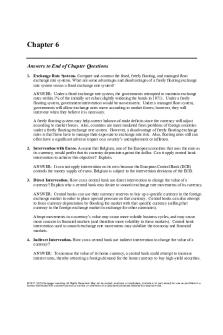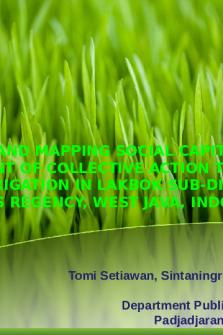Social Lecture 2 - measuring prejudice through direct and indirect measures PDF

| Title | Social Lecture 2 - measuring prejudice through direct and indirect measures |
|---|---|
| Course | Investigating Psychology |
| Institution | Lancaster University |
| Pages | 3 |
| File Size | 90.1 KB |
| File Type | |
| Total Downloads | 70 |
| Total Views | 139 |
Summary
measuring prejudice through direct and indirect measures...
Description
PSYC 102: INVESTIGATING PSYCHOLOGY SOCIAL LECTURE 2: MEASURING PREJUDICE Learning Outcomes Introduce key definitions/ concepts A couple of classic perspectives Measuring prejudice o Indirect measurement o Direct measurement Prejudice Prejudice – a biased attitude or feeling towards another group (or members of another group) based on generalisation about what that group is like Prejudice as a feeling – “prejudice represents a negative feeling towards outgroup members” (Nelson, 2013) o Affect – prejudice (negative affect) o Behaviour – discrimination (negative) o Cognition – stereotypes (negative) Prejudice as an attitude – has an affective, behavioural and cognitive component Behaviour and Cognition Discrimination (behaviour) – actions or behaviour, toward an individual or group based on their perceived group identity/membership Stereotypes (cognition) – Specific beliefs about members of another group, generalized from beliefs about the group itself
Why are we prejudiced? Personality Realistic conflict theory Social identity theory Cognitive misers Group norms and conformity
Personality Authoritarianism (Adorno et al., 1950) Motivated by the Holocaust The F(ascist) Scale o Conventionalism o Authoritarian Submission [ingroup] o Authoritarian Aggression [convention violators] Anti-interception o Superstition o Power o Cynicism o Projectivity o Sexual Concerns Right- versus Left-wing Social dominance orientation (Pratto et al, 1994)
o Social dominance theory (SDT) Society minimises conflict through ideologies that create hierarchical structures SDO = attitudinal aspect of SDT Some groups of people are simply inferior to other groups It is unjust to try to make groups equal Authoritarianism o My beliefs and those of my ingroup are objectively correct. Anyone who is different from us is a problem Social dominance orientation o The world is a zero-sum game. If someone wins, someone else must lose Both tend to predict things like: o Discriminatory towards minority groups, opposition to social policies designed to improve welfare of minority groups, beliefs that legitimise inequality
Cognitive Misers Walter Lippmann (1922) o Public Opinion For the most part we do not first see, and then define, we define first and then see. In the great blooming, buzzing confusion of the outer world we pick out what our culture has already defined for us, and we tend to perceive that which we have picked out in the form stereotyped for us by our culture. Gordon Allport o The human mind must think with the aid of categories... Once formed, categories are the basis for normal prejudgment. We cannot possibly avoid this process. Orderly living depends upon it. See also: Pendry & Macrae (1994) Measuring Prejudice Direct measure o Self-report o “if you want to know something about someone, just ask” o Closed-set vs open-ended Pros and cons to both o Strengths Fast and easy, “direct”, quantitative o Weaknesses Lack of desire, or lack of ability, to report accurately, “bogus pipelines” Indirect measure o Many different approaches Constrative vignettes Matched guise technique Behavioural measures “interview offers” o Psychological measures Heart rate
Eye tracking Facial activity EEG/ MRI o Adams, Wright, Lohr (1996) Implicit measures o 99%, or possibly 99.9%, of our activity is purely automatic and habitual (William James, 1899) o Implicit measures – “opposite or explicit measures” Non-conscious, not directly assessible Attitude is “implicit” to the behaviour/ measure o Word fragment completion test Gilbert and Hixon (1991) Complete as many fragments as possible in 15 seconds o Fazio et al (1995) The “evaluate priming” task Looking at reaction times to pairing of positive/ negative concepts with different social categories o Strengths Cheap, practical, bypasses response biases o Weaknesses Validity Ecological, predictive validity unclear Relies on the assumption that association = attitude
Summary Definition: prejudice as affect/ attitude History: some classical perspectives Measure types: o Direct (explicit) o Indirect (implicit)...
Similar Free PDFs

Direct and indirect questions
- 3 Pages

Financement direct vs indirect
- 7 Pages

Direct vs indirect chart
- 1 Pages

Pride and Prejudice Glossary
- 4 Pages

8. Pride and Prejudice
- 6 Pages
Popular Institutions
- Tinajero National High School - Annex
- Politeknik Caltex Riau
- Yokohama City University
- SGT University
- University of Al-Qadisiyah
- Divine Word College of Vigan
- Techniek College Rotterdam
- Universidade de Santiago
- Universiti Teknologi MARA Cawangan Johor Kampus Pasir Gudang
- Poltekkes Kemenkes Yogyakarta
- Baguio City National High School
- Colegio san marcos
- preparatoria uno
- Centro de Bachillerato Tecnológico Industrial y de Servicios No. 107
- Dalian Maritime University
- Quang Trung Secondary School
- Colegio Tecnológico en Informática
- Corporación Regional de Educación Superior
- Grupo CEDVA
- Dar Al Uloom University
- Centro de Estudios Preuniversitarios de la Universidad Nacional de Ingeniería
- 上智大学
- Aakash International School, Nuna Majara
- San Felipe Neri Catholic School
- Kang Chiao International School - New Taipei City
- Misamis Occidental National High School
- Institución Educativa Escuela Normal Juan Ladrilleros
- Kolehiyo ng Pantukan
- Batanes State College
- Instituto Continental
- Sekolah Menengah Kejuruan Kesehatan Kaltara (Tarakan)
- Colegio de La Inmaculada Concepcion - Cebu










